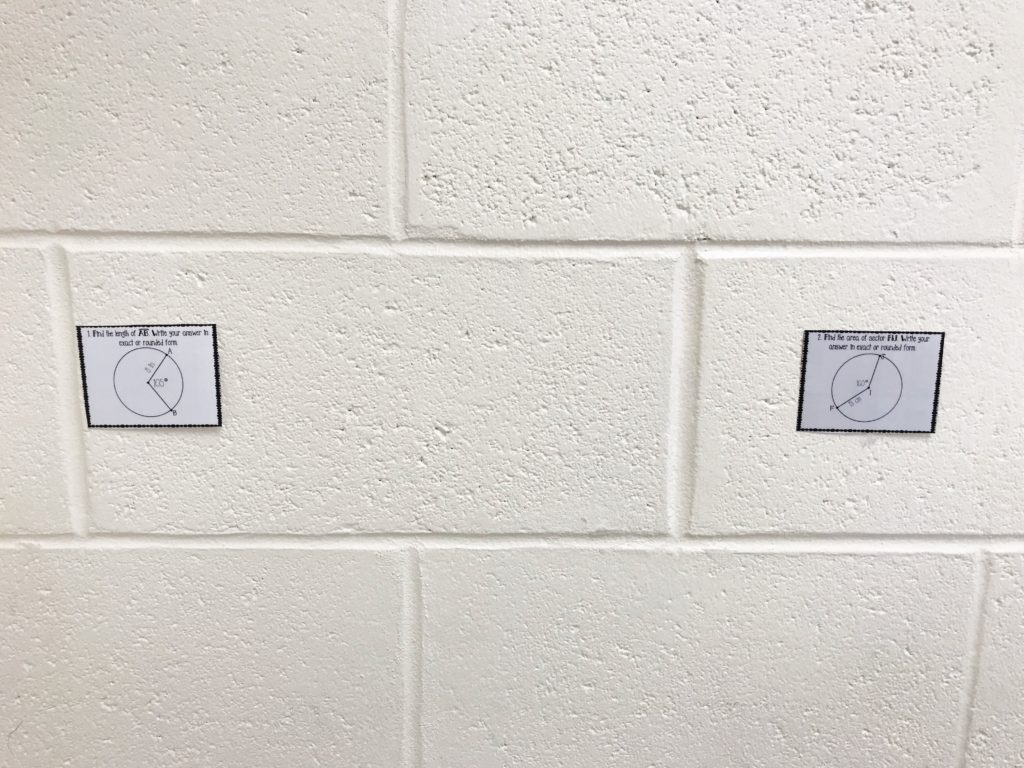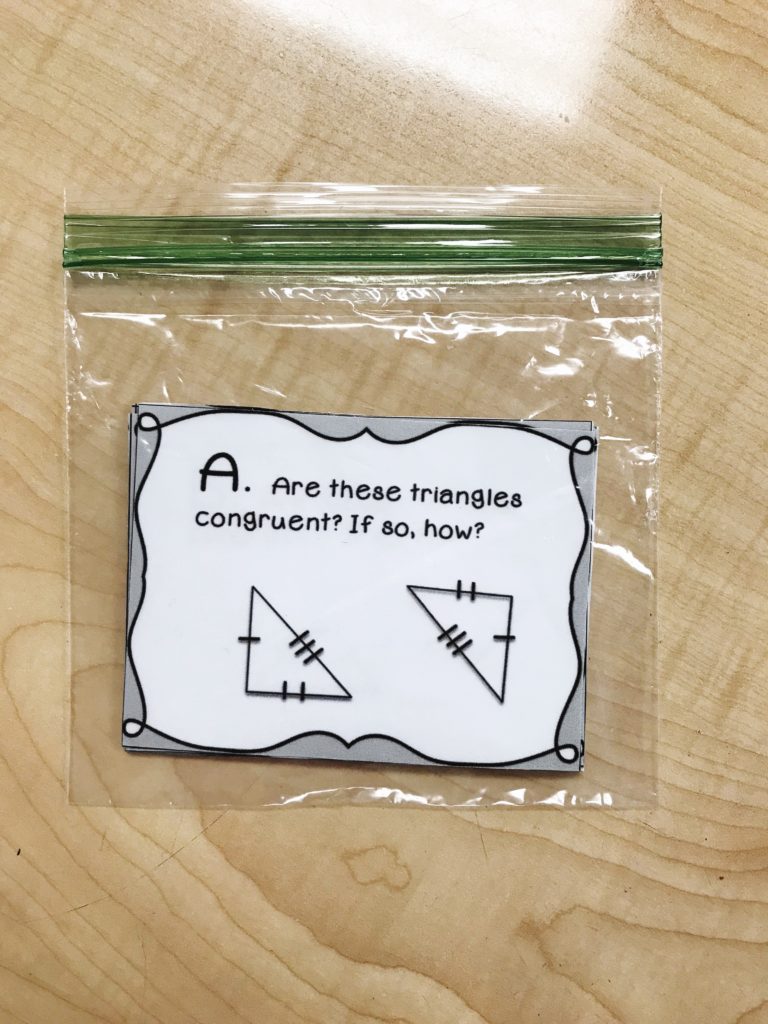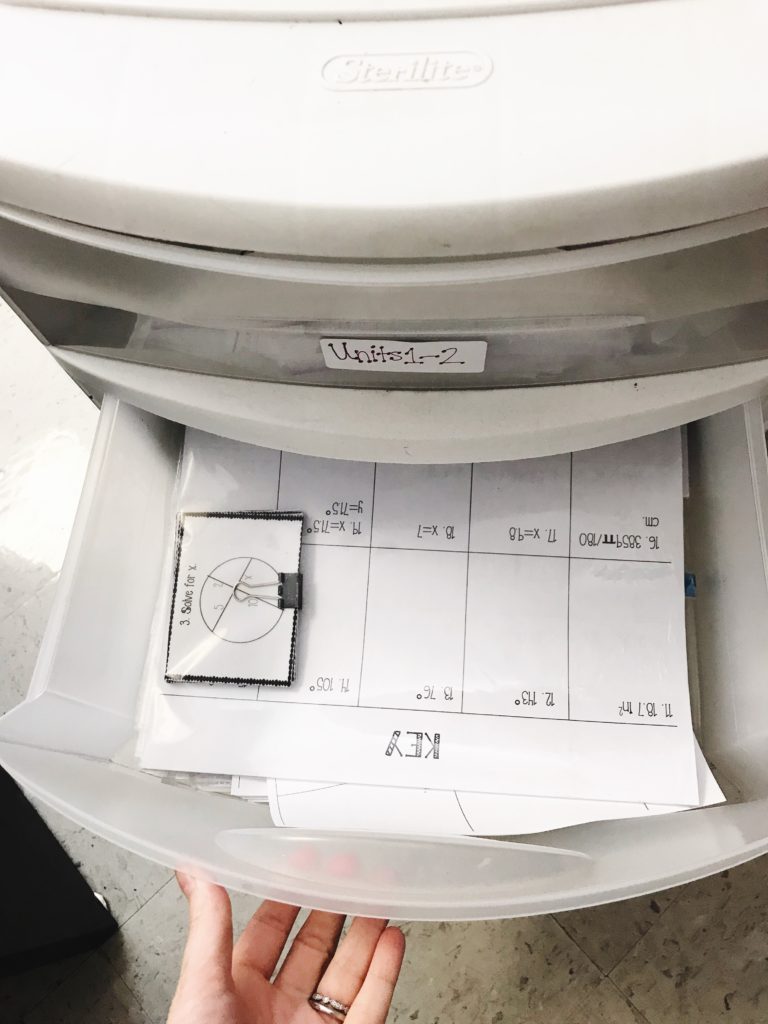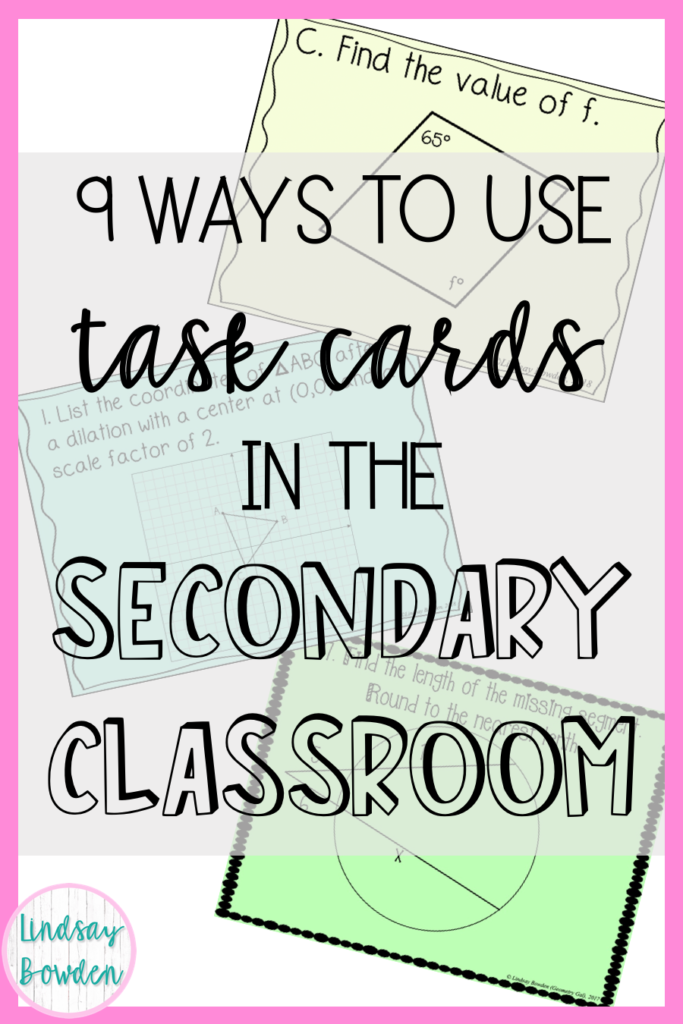
Task cards are an easy way to incorporate games into the middle and high school classroom. They are also a great way to utilize technology in the classroom. As a high school math teacher, I used task cards on a weekly basis. This post has all of my task card ideas for middle and high school. You can find all the task cards I’ve created by clicking here.
Want to create engaging resources, including task cards, head to LindsayBowden.com/Training to sign up for my FREE training on creating engaging resources!
What is a task card?
Okay—before we get into my best task card ideas…is anyone thinking “what the heck is a task card?!” Because that’s where I was a few years ago when I started seeing them on Instagram, Facebook, and Teachers Pay Teachers.
A task card is basically an index card size paper (about 1/4 or 1/6 of a normal piece of paper) that has a problem or task on it. Math task cards usually have one math problem per task card.
The cards come in a set of about 10-20 and usually have a student answer sheet and an answer key.
Where do I find task cards?
The best teacher-created task cards can be found on Teachers Pay Teachers. This website is where teachers create resources to sell to other teachers.
You can find all of my task cards here. If you don’t want to buy task cards, you can always make your own.
I use PowerPoint to make all of my task cards. Click here to see how I make my own math resources!
Why task cards?
So…what’s the benefit of using task cards? Why am I sharing my favorite task card ideas? Why not just give students a practice worksheet?
Well, task cards are a way to practice math skills (or any subject) in a more fun and engaging way. I’m all about getting BEYOND the worksheet. Now, don’t get me wrong. Worksheets have their time and place, especially in the math classroom.
I usually give students a worksheet with 8-12 problems after a lesson because I want to see their work and allow them time to practice the skill. After the worksheet, I try to incorporate another type of activity like task cards.
I have found the change of pace is helpful for many students. Many of my task card activities are kinesthetic so the students get to MOVE (oh hey, differentiation).
This article contains affiliate links to products. I may receive a commission for purchases made through these links.
Alright here they are! 9 student-approved ways to use task cards in the secondary classroom:
1. Around the room (or Hallway)

Around the room is my favorite task cards idea! In this task cards game, I hang the task cards in order (they are usually numbered) around my classroom or hallway right outside my classroom.
I print a student answer sheet for each student (or for each pair if I let them work in partners). Students can start at any task card. For classes that need a bit more structure, I will give each student or pair specific directions (example: “start at task card 2”).
This way, they do not all crowd around one card. Then, they go in order from that card on until they get back to the card where they started.
I bought clipboards at the Dollar Tree for them to use while doing this activity. You could also have students use their notebook. When they have completed all the cards, they either self-check with an answer key or turn it in for me to grade. This was my students favorite high school math game!
2. Fast Finishers

We all have those few students who finish everything early and exclaim, “What do I do now?!”
My first couple years of teaching I would just say, “find something quietly to do.” But, I finally wised up and realized I could find a better way to utilize their time.
I keep a few sets of task cards in baggies that I give to these students. The task cards could be review material or something we are currently learning. The students answer the task cards on their own sheet of paper or a student answer sheet (if I have one printed).
Then, I either let them self-check with an answer key or turn it in to me. Occasionally, I will count this as extra credit for these students.
3. Warm Up/Bell Ringer
If my warm ups are getting a little bland, I will use task cards as a fun alternative. As students walk in, I hand them a task card. They write their answer on their warm up answer sheet. You can get my free warm up answer sheet here.
Then, I put the answers on my smart board (you could also use a document camera). Students will know which answer matches their card because the task cards are usually numbered. If you don’t want to go over 20 different task cards, you could pick 3-5 task cards and just give out multiples of the same card. Then, you can go over these 3-5 problems as a whole group.
4. Closing/Ticket Out the Door
This one is similar to warm ups. At the end of the lesson, I give each student a task card. They must answer before they leave. You can have students write their answer on a piece of paper or sticky note and turn it in as they leave as a ticket out the door. A great way to wrap up the lesson!
5. Partner
You can assign partners and allow them to complete the task cards together! They could split up the task cards and then check each other for mistakes.
6. Digital

If you are a 1 to 1 school (every student has a laptop or tablet) or you have a class set of laptops or tablets, you can use the task cards digitally. You can put a PDF of the task cards on to a learning management system (Schoology, Blackboard, etc.) or use Google classroom.
When you buy task cards on Teachers Pay Teachers, they usually come in PDF format already. Student sit at their desks and answer the task cards on a student answer sheet. You could also have them turn in their answers digitally, but I like to see their work.
7. Stations

For stations, I arrange my classroom into groups of 3-5 desks. I push the desks together to create a station.
I put about 4-6 task cards at each station. Students start at a station, answer the task cards at that station, then rotate to the next station. I set a timer so that all the students rotate at one time.
The students can work together with the peers at their station to answer the questions. Incorporating cooperative learning is one of my favorite task card ideas.
8. Whole Group
If you have an interactive whiteboard or document camera, you can display the task cards one at a time for the whole class. I will give students an answer sheet to turn in or have them use dry erase markers and write their answers on their desks (our desks are dry erase compatible ). You can also use mini dry erase boards. After every student has answered, I will go over the question with the class.
9. Extra Time
Have you ever planned an awesome lesson that should last the whole class period, and the students finish in 20 minutes? I’ve definitely been there!
In these situations, I always rely on my task card ideas! I always keep student answer sheets copied and ready to go. Then I pass out a task card to each student and have them rotate the task cards. For bigger classes, I use two sets of cards. You could also have the task cards stay at a desk and let the students rotate (for those classes that need some extra movement).
I hope these 9 task card ideas are helpful! If you enjoyed this post, I would love if you help spread the word by sharing it with a friend, Facebook, or Instagram. Do you have questions or more strategies for task cards? Let me know in the comments below.
Bonus: Task Card Storage
I store my task cards by unit in this bin. You can find a similar bin here. This helps me quickly grab the task cards when I need them! Find more awesome ideas for math teacher supplies here!

For each set of task cards, I make sure to have the cards pre-cut, the student answer sheets, and the answer key.

Hope this was helpful!
If you want some other great secondary classroom activity ideas, check out my friend’s blog here at Students of History. He’s also got great history resources on his site!
How do you use task cards? Let me know below! Happy teaching!
Head to LindsayBowden.com/Training to sign up for my FREE training on creating engaging resources!







